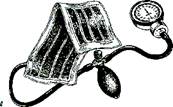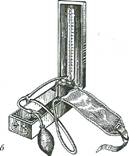Fig. 27.Taking the pulse on the radial artery, on the carotid artery
The following properties of arterial pulse are to be defined:
1. Rhythm – is assessed by the regularity of two pulse-waves following each other. If the intervals between them are equal, the pulse is considered to be right (regular pulse), if the intervals are different, it is considered to be wrong (irregular). In case of atrial fibrillation (“heart delusion”) the heart rate can be exceed the number of pulse-waves. In such cases miosphygmia is verified and counted.
2. Frequency – the number of pulse-waves a minute. Normally pulse frequency varies between 60 and 90 beats a minute but it can change significantly depending on sex, age, air and body temperature, level of physical activity. Pulse is the most frequent during the pre-natal period. At the age of 25-60 pulse remains relatively stable. Women’s pulse is more frequent than men’s; that of sportsmen, trained and elderly people is less frequent. Heart acceleration appears in vertical position, during physical activity and with body temperature rise. Heart-rate fall to 60 beats is called bradyrhythmia and heart acceleration over 90 – tachyrhythmia.
3. Strength of pulse is defined by the volume of the blood that is in the artery and depends on the ventricular ejection. When the pulse is strong the pulse-wave is high, well perceptible, when the pulse is weak, the pulse-wave is low, badly perceptible. Hardly perceptible, weak pulse is called thready, at its disclosure the nurse must immediately report to the doctor.
4. Tension is defined by the force that has to be applied to completely constrict the artery. When the arterial pressure is high the pulse will be tense or cordy, when the pressure is low – soft.
5. Height of pulse and its size depend on the range of the arterial wall. When the ventricular ejection increases and in case of arterioatony, pulsus magnus is observed, and in case of low cardiac output, shock, collapse – low and small.
6. Velocity or shape of pulse is defined by the speed of change of volume of artery. Fast ejection and collapse of the artery are characteristic of abrupt pulse (in cases of aortic insufficiency), and slow ejection and collapse of the artery – of pulsus tardus (in cases of aortic stenosis).
The data drawn from taking the pulse are registered in the temperature form by the nurse (they are marked by red dots).
Arterial pressure, technique of measuring it.
Notion of arterial hypertension, hypertensive crisis, arterial hypotension
Arterial pressure (AP) is the one that is generated in the arterial system as the heart works. Depending on the period of cardiac cycle, the pressure will be systolic (SAP), the one that is generated right after the systole of left ventricle (corresponds to the maximum rise of the pulse-wave), or diastolic (DAP), which remains in arteries during diastole due to their tone (corresponds to the fall of the pulse-wave). The difference between SAP and DAP is called pulse pressure.
AP depends on the volume of cardiac output, general peripheral vascular resistance, heart rate. Measuring AP is an important method of monitoring circulatory dynamics of both healthy and sick people.
Measuring AP can be performed by a direct and indirect method. The direct method consists in introducing the sensing device of manometer directly into the bloodstream. This method is used during catheterization to measure pressure in large vessels or in heart cavities. Usually AP is measured by the indirect auscultatory method introduced in 1905 by Russian surgeon N. S. Korotkov using sphygmomanometer (tonometer). Sphygmomanometer consists of mercurial or, more often, of spring manometer, connected with pressure cuff and rubber bag (Fig.28). Entry of air into the pressure cuff is regulated by a special valve that makes it possible to keep and gradually lower the pressure in the cuff. AP is measured by the resistance force of the spring (in Mmhg), which is transmitted to the pointer that moves on the dial-piece with millimeter graduation.


